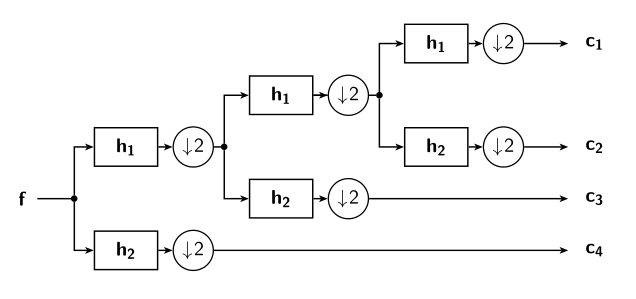FWT - Fast Wavelet Transform
Usage
c = fwt(f,w,J); c = fwt(f,w,J,dim); [c,info] = fwt(...);
Input parameters
| f | Input data. |
| w | Wavelet definition. |
| J | Number of filterbank iterations. |
| dim | Dimension to along which to apply the transform. |
Output parameters
| c | Coefficient vector. |
| info | Transform parameters struct. |
Description
fwt(f,w,J) returns discrete wavelet coefficients of the input signal f using J iterations of the basic wavelet filterbank defined by w using the fast wavelet transform algorithm (Mallat's algorithm). The coefficients are the Discrete Wavelet transform (DWT) of the input signal f, if w defines two-channel wavelet filterbank. The following figure shows DWT with J=3.

The function can apply the Mallat's algorithm using basic filterbanks with any number of the channels. In such case, the transform have a different name.
Several formats of the basic filterbank definition w are recognized. One of them is a text string formed by a concatenation of a function name with the wfilt_ prefix followed by a list of numerical arguments delimited by :. For example 'db10' will result in a call to wfilt_db(10) or 'spline4:4' in call to wfilt_spline(4,4) etc. All filter defining functions can be listed by running dir([ltfatbasepath,filesep,'wavelets',filesep,'wfilt_*']); Please see help of the respective functions and follow references therein.
For other recognized formats of w please see fwtinit.
[c,info]=fwt(f,w,J) additionally returns struct. info containing transform parameters. It can be conviniently used for the inverse transform ifwt e.g. as fhat = ifwt(c,info). It is also required by the plotwavelets function.
If f is row/column vector, the subbands c are stored in a single row/column in a consecutive order with respect to the inceasing central frequency. The lengths of subbands are stored in info.Lc so the subbands can be easily extracted using wavpack2cell. Moreover, one can pass an additional flag 'cell' to obtain the coefficient directly in a cell array. The cell array can be again converted to a packed format using wavcell2pack.
If the input f is a matrix, the transform is applied to each column if dim==1 (default) and [Ls, W]=size(f). If dim==2 the transform is applied to each row [W, Ls]=size(f). The output is then a matrix and the input orientation is preserved in the orientation of the output coefficients. The dim paramerer has to be passed to the wavpack2cell and wavcell2pack when used.
Boundary handling:
fwt(f,w,J,'per') (default) uses the periodic extension which considers the input signal as it was a one period of some infinite periodic signal as is natural for transforms based on the FFT. The resulting wavelet representation is non-expansive, that is if the input signal length is a multiple of a \(J\)-th power of the subsampling factor and the filterbank is critically subsampled, the total number of coefficients is equal to the input signal length. The input signal is padded with zeros to the next legal length L internally.
The default periodic extension can result in "false" high wavelet coefficients near the boundaries due to the possible discontinuity introduced by the zero padding and periodic boundary treatment.
fwt(f,w,J,ext) with ext other than 'per' computes a slightly redundant wavelet representation of the input signal f with the chosen boundary extension ext. The redundancy (expansivity) of the represenation is the price to pay for using general filterbank and custom boundary treatment. The extensions are done at each level of the transform internally rather than doing the prior explicit padding.
The supported possibilities are:
| 'zero' | Zeros are considered outside of the signal (coefficient) support. |
| 'even' | Even symmetric extension. |
| 'odd' | Odd symmetric extension. |
Note that the same flag has to be used in the call of the inverse transform function ifwt if the info struct is not used.
Examples:
A simple example of calling the fwt function using 'db8' wavelet filters.:
[f,fs] = greasy; J = 10; [c,info] = fwt(f,'db8',J); plotwavelets(c,info,fs,'dynrange',90);
Frequency bands of the transform with x-axis in a log scale and band peaks normalized to 1. Only positive frequency band is shown.
[g,a] = wfbt2filterbank({'db8',10,'dwt'});
filterbankfreqz(g,a,20*1024,'linabs','posfreq','plot','inf','flog');
References:
S. Mallat. A wavelet tour of signal processing. Academic Press, San Diego, CA, 1998.